The Z-Bar Shoe: A Closer LookReprinted with permission from the Farrier Products Distribution. |
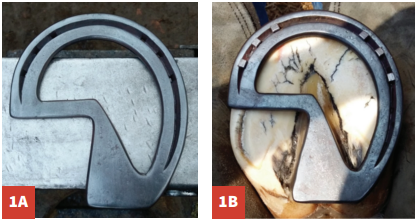 |
| Fig. 1A shows a well forged Z bar shoe with an adequate frog plate. Fig. 1B shows the same shoe attached to a foot. Note the frog plate covering the frog. (Courtesy of Jacques Kruger - South Africa). |
Therapeutic Considerations
It is important to realize and understand the functionality of a bar shoe. They provide stability to the hoof capsule by the nature of the bar joining the two branches of the shoe together; placing a bar between the heels of a shoe adds several inches of ground contact surface area to the foot; they provide local protection and recruitment of additional weight bearing structures of the foot. The continuity of the bar shoe around the perimeter of the hoof capsule allows a section of the hoof capsule to be unloaded as there will be a weight bearing surface in front of and behind the affected area. Furthermore, bar shoes decrease the independent vertical movement of the heels thereby reducing movement and stabilizing the structures in the palmar / plantar section of the foot.
It may be helpful to consider therapeutic principles when trying to decide on the best farriery approach for a foot with a compromised heel / quarter or heel. The therapeutic principles of farriery used to promote healing of any injured / diseased tissue or a hoof wall defect are:
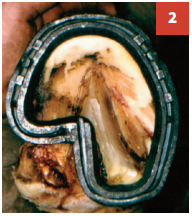 |
| Fig.2. shows a Z bar show without a frog plate which prevents redistributing the weight of the horse to another section of the foot. |
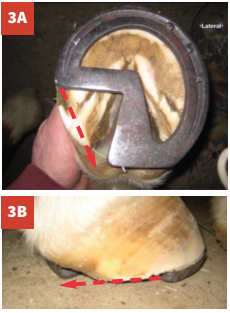 |
| Fig. 3A and 3B. Note the fulcrum effect (red arrows) of the Z bar shoe and the leverage on the hoof wall palmar / plantar to the end of the shoe. |
Perhaps the Z bar shoe should be considered a partial bar shoe. The bar of the Z bar is shaped with 2 90° bends such that one leg of the Z is attached to the quarter of one branch of the shoe and the other leg is attached to the heel of the opposite branch. This configuration affords no protection to the section of hoof wall not covered by the shoe and leaves it vulnerable to trauma from the surface below. The Z bar shoe has limited ability to unload or decrease the forces on the exposed section of the hoof wall. The Z bar shoe offers a floatation effect when the horse stands or walks on a hard-flat surface as the affected area is off the surface. However, if the horse stands or is moved on a deformable surface such as sand, synthetic arena footing, grass paddock, etc.; the weight of the horse will force the shoe to sink in the footing and the unprotected quarter / heel will be directly engaged with the surface. The same thing happens when the horse is in the stall standing on sawdust, shavings or other type of bedding but to a lesser degree. Furthermore, if we consider the point in the quarter of the foot where the Z bar turns medially toward the frog; this forms a fulcrum placing leverage on the quarter / heel palmar or plantar to this point (Figure 3). Therefore, when the horse is weight bearing, this leverage will create an additional force on this area in a distal direction
The Z bar shoe would appear to be able to redistribute a limited amount of weight bearing to other parts of the foot. However, in order to transfer load, the Z bar would have to have an adequate frog plate that would cover the frog. Furthermore, the frog and related structures would have to be of sufficient mass and healthy in order to accept some of the weight bearing function and make the palmar / plantar section of the foot ‘load sharing’. The Z bar shoe is hard to make properly, so many cases seen in practice are just a Z formation without the necessary frog plate which then has no ability to redistribute load and would actually render the foot unstable (Figure 2). Secondly, the ability to redistribute weight is further limited, due to the leverage and the force exerted on the exposed hoof wall as some of the load will be placed here rather than over the entire foot if a full bar shoe was used.
One last point that needs to be considered is how the forelimb (limb) conformation affects the landing pattern of the horse. If a horse lands slightly lateral heel first and has a lateral heel injury; removing a section of the shoe that exposes the compromised heel will alter the landing pattern and increase the force during the landing phase of the stride. A horse with a rotational deformity or an offset foot will land asymmetrically and load the foot disproportionally with excessive load being placed on the medial side of the foot (sheared heels). As many injuries and hoof wall defects (quarter cracks) occur medially; this will add excessive force to the unprotected hoof wall which is not conducive to healing
Alternative Farriery Solutions
There are many farriery methods to implement the therapeutic principles of protecting and unloading a compromised section of the foot and then redistributing the load to a better section of the foot. Any discussion of therapeutic farriery and its ultimate success has to start with and rely on a good basic trim. 1,2,3 Briefly, a line is drawn across the widest part of the foot, the frog is trimmed to remove exfoliating horn and the heels of the hoof capsule are trimmed to the base of the frog or to a point where the hoof wall at the heels and the frog are on the same horizontal plane. The toe length is reduced accordingly such that there are approximate proportions of surface area on either side of the line drawn across the middle of the foot (Figure 4). Once a shoe is chosen, the hoof wall on the affected side is again trimmed from the toe quarter to the heel in a tapered fashion to create a ‘pie shaped’ space between the shoe and the hoof. 4
|
|
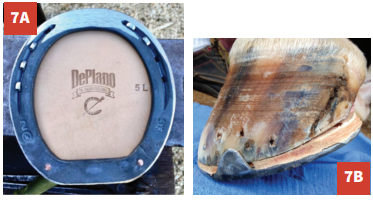 |
| Fig. 7A and 7B. Kerckhaert SX-8 straight bar shoe with impression material. Note the space created between the hoof surface and the shoe. |
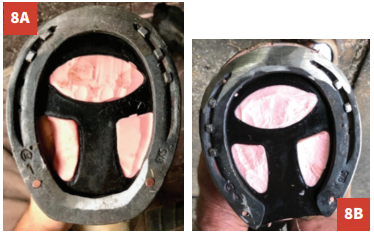 |
| Fig. 8A and 8B. Kerckhaert SX-8 straight bar shoe with spider plate. Note impression material removed under medial quarter / heel. Open shoe with spider plate and impression material. Note stiffness of spider plate will create a bar shoe effect. |
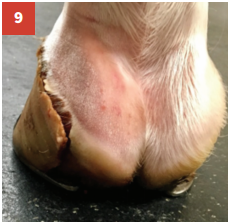 |
| Fig. 9. Complete avulsion of medial hoof wall from toe quarter to heel. |
Shoe Options
There are many shoe or shoe combinations that can be used. The shoe choice should be based on the severity and extent of the damage or defect in the affected section of hoof wall. All the shoes mentioned will protect the affected area. If it is a simple defect such as a quarter crack, a simple bar shoe is generally sufficient. The continuity of the bar shoe stabilizes the hoof capsule and allows the section of the hoof wall with the defect to be unloaded (Figure 5). Added stability can be added by using a heart bar shoe which has the ability to transfer some of the load to the frog and palmar foot. In order for the heart bar shoe to be effective, it is necessary to have a healthy frog of sufficient mass (Figure 6). Another option to redistribute the weight is to use a bar shoe with some form of pad. Before applying the shoe and pad, impression material will be added to the solar surface of the foot except under the affected section of the foot so that area stays unloaded (Figure 7). An excellent combination to protect / unload the compromised hoof wall and redistribute the load on the foot is to use a bar shoe with a spider plate and impression material. Again, the impression material is removed from beneath the affected hoof wall (Figure 8).
A Clinical Case Using Farriery Principles
A 14-year-old upper level event horse suffered a severe avulsion of the right fore medial hoof wall from the toe quarter to the heel (Figure 9). Immediately after the injury, he was placed in a foot cast for 5 days and received antibiotics. When presented out of the cast, he was toe-touching lame with a marked digital pulse. Pressure on the avulsed area of the foot showed marked pain. To initiate the principles discussed above, the horse was placed in a wooden shoe which allowed the avulsed side of the foot to be unloaded and the weight to be redistributed across the foot due to the flat solid surface of the block (Figure 10). The horse immediately became sound. As there was no infection present, the detached section of hoof wall was left in place to act as a 'Band-Aid'. There was solid hoof wall growth at the coronet a month later and the horse was changed to a bar shoe / pad / impression material combination (Figure 11). At the second reset (8 weeks), the hoof wall can be seen growing down solid and evenly (Figure 12). Small portions of the detached wall have been removed periodically with solid cornified horn underneath. The horse is turned out and the hoof wall has continued to grow down uneventfully.
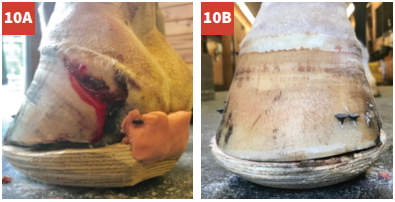 |
| Fig. 10A and 10B. Wooden shoe at an initial farriery. Note wall unloaded and screws inserted in toe. |
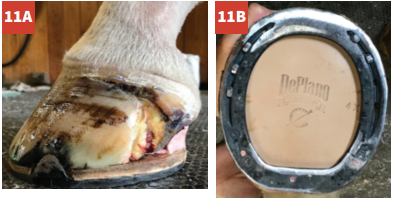 |
| Fig. 11A and 11B. Kerckhaert SX-8 straight bar shoe with leather pad and impression material at 4 weeks |
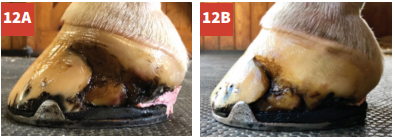 |
| Fig. 12A and 12B. Reset at 8 weeks (12A) and 12 weeks (12B). Note hoof wall growth at coronet. |
Conclusion
Farriery is both an art and a science. I like to use a thought process based on principles when devising a therapeutic plan. In most cases the principles for damaged tissue will be to protect, take the force of it and redistribute some of the weight bearing function to another part of the foot. I try not to think about what I did on the last case but what I’m going to do for this case. There are always a variety of ways to apply principles.